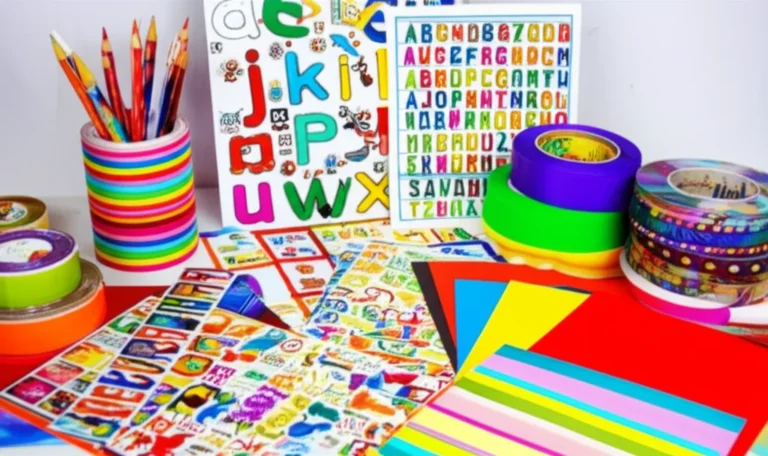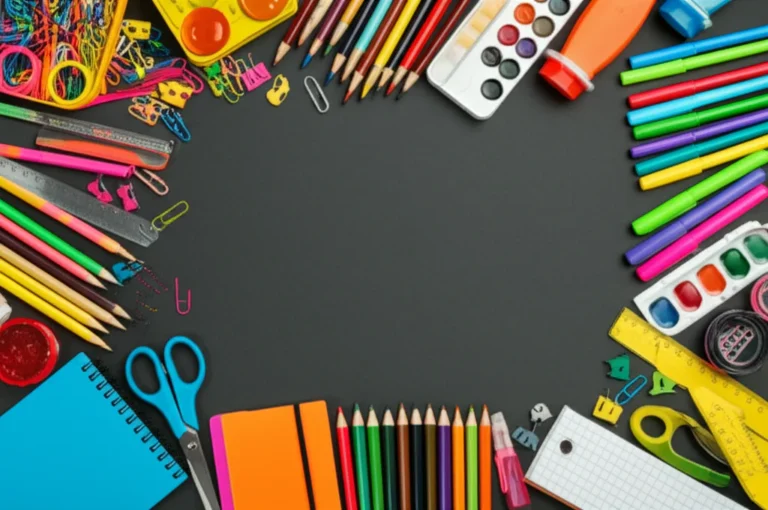Support our educational content for free when you purchase through links on our site. Learn more
The Ultimate 60+ Item Elementary Teacher Supply List (2025) 🎒
Every new school year kicks off with the same challenge: assembling the perfect elementary teacher supply list that balances essentials, budget, and classroom magic. Did you know that the average teacher spends over $500 out of pocket on supplies annually? 😲 We’ve been there, sifting through aisles and online carts, hunting for durable crayons, reliable glue sticks, and tech tools that actually make a difference.
In this comprehensive guide, we break down 60+ must-have supplies tailored for every elementary grade — from kindergarten’s jumbo crayons to fifth grade’s tech-savvy gadgets. Plus, we reveal insider shopping hacks, organizational secrets, and tips to avoid common pitfalls that can turn your supply haul into a headache. Curious about the future of classroom supplies or how to stretch your budget without sacrificing quality? Stick around — we’ve got all that and more!
Key Takeaways
- Grade-specific supplies matter: Tailor your list to your students’ developmental needs, from sensory tools in kindergarten to calculators in upper grades.
- Invest in trusted brands: Crayola, Elmer’s, and Fiskars consistently deliver quality that lasts.
- Organization is a game-changer: Label bins, create supply stations, and keep an emergency stash to stay ahead.
- Smart shopping saves money: Use community donations, bulk buys, and digital wish lists to stretch your budget.
- Tech is essential: Document cameras, tablets, and interactive whiteboards are no longer optional extras.
👉 Shop top-rated classroom essentials:
- Crayola Crayons | Elmer’s Glue Sticks | Fiskars Safety Scissors | Brother P-touch Label Makers | IPEVO Document Cameras
Ready to build your ultimate supply list and teach with confidence? Let’s dive in!
Table of Contents
- ⚡️ Quick Tips and Facts for Savvy Educators
- 📚 The Evolution of the Elementary Classroom: A Supply Story
- 🍎 Grade-Level Goldmines: Essential Supplies for Every Elementary Classroom
- 1. Kindergarten Kicks Off: Supplies for Little Learners
- 2. First Grade Fun: Building Blocks of Learning
- 3. Second Grade Success: Stepping Up the Supply Game
- 4. Third Grade Thrills: Independent Learners, Independent Supplies
- 5. Fourth Grade Focus: Deepening Knowledge, Diversifying Tools
- 6. Fifth Grade Finesse: Preparing for Middle School & Beyond
- ✨ Beyond the Basics: Classroom Comforts & Teacher Treasures
- 💰 Smart Shopping & Budgeting Brilliance: Making Every Dollar Count
- 💸 Unlocking Savings: Tax Deductions & Financial Perks for Teachers
- 🚧 Supply Snafus: Common Pitfalls to Avoid When Stocking Up
- 🚀 The Future Classroom: What’s Next for Elementary Teacher Supplies?
- 🎉 Wrapping It Up: Your Ultimate Supply Success Story
- 🔗 Recommended Resources: Dive Deeper into Teacher Supplies
- ❓ Your Burning Questions Answered: Elementary Teacher Supply FAQ
- 📚 Our Go-To Guides: Trusted Reference Links
⚡️ Quick Tips and Facts for Savvy Educators
Welcome to the ultimate insider’s guide on the elementary teacher supply list! Before we dive into the nitty-gritty, here are some quick nuggets from our Teacher Supply Store™ pros to get you started:
- ✅ Teachers spend an average of $500 annually on classroom supplies out of pocket, according to the National Center for Education Statistics. (See our deep dive on What Percentage of Teachers Buy Their Own Supplies? 📚)
- ✅ Stock up early! Many supplies go out of stock fast during back-to-school season.
- ✅ Quality over quantity: Durable brands like Crayola, Elmer’s, and Fiskars last longer and save money in the long run.
- ✅ Don’t forget tech! Tablets, document cameras, and interactive whiteboards are becoming classroom staples.
- ✅ Organization is your best friend. Label bins, color-code supplies, and use storage carts to keep chaos at bay.
💡 Pro Tip: Always keep a small emergency stash of essentials like glue sticks and dry erase markers. You’ll thank yourself mid-lesson!
Ready to unpack the full supply saga? Let’s roll!
📚 The Evolution of the Elementary Classroom: A Supply Story
Elementary classrooms have transformed dramatically over the decades. Gone are the days of chalkboards and dusty textbooks alone. Today’s classrooms are vibrant hubs of creativity, technology, and hands-on learning — and the supply list reflects that evolution.
From Chalk to Clicks: A Brief History
- 1950s-70s: Basic supplies like pencils, paper, and chalk dominated.
- 1980s-90s: Introduction of overhead projectors, laminators, and early computers.
- 2000s-Present: Tablets, interactive whiteboards, and STEM kits have become essential.
This shift means teachers need a diverse arsenal of supplies to meet varied learning styles and tech integration. For example, a simple pack of washable markers now shares shelf space with coding kits and digital tablets.
Want to know how this impacts your supply list? Keep reading to discover grade-specific essentials!
🍎 Grade-Level Goldmines: Essential Supplies for Every Elementary Classroom
Every grade has its own vibe and needs. We’ve broken down the must-haves for each level, so you can tailor your list perfectly.
1. Kindergarten Kicks Off: Supplies for Little Learners
Kindergarten is all about sensory exploration and fine motor skills. Supplies here focus on safety, durability, and fun.
| Supply Item | Recommended Brand(s) | Why It’s Essential |
|---|---|---|
| Jumbo Crayola Crayons | Crayola | Easy grip for tiny hands, non-toxic |
| Washable Glue Sticks | Elmer’s | Safe and mess-free bonding |
| Safety Scissors | Fiskars | Rounded tips, perfect for beginners |
| Dry Erase Markers | Expo | For interactive whiteboard activities |
| Play-Doh | Hasbro | Encourages creativity and fine motor skills |
Teacher Tip: Use colorful bins and labels to help kids learn organization early.
2. First Grade Fun: Building Blocks of Learning
First graders start mastering writing and basic math. Supplies evolve to include more structured tools.
- Pencils with erasers (Ticonderoga is a classic favorite)
- Composition notebooks (wide-ruled)
- Manipulatives like counting bears or base ten blocks
- Whiteboard erasers and cleaning spray
- Stickers and stamps for positive reinforcement
3. Second Grade Success: Stepping Up the Supply Game
Second graders need supplies that support reading fluency and math problem-solving.
- Highlighters (Sharpie Accent)
- Rulers with both inches and centimeters
- Index cards for vocabulary flashcards
- Pencil sharpeners with containers
- Colored pencils (Prismacolor Scholar for quality)
4. Third Grade Thrills: Independent Learners, Independent Supplies
Third grade is a turning point — students become more independent and start projects.
- Glue sticks and liquid glue (Elmer’s School Glue)
- Scissors with sharper blades
- Graph paper notebooks for math
- USB flash drives for saving digital work
- Headphones for computer time
5. Fourth Grade Focus: Deepening Knowledge, Diversifying Tools
Fourth graders tackle complex subjects and need supplies that support critical thinking.
- Scientific calculators (Texas Instruments TI-30X)
- Composition notebooks with durable covers
- Dry erase boards for group work
- Sticky notes in multiple sizes
- Art supplies like watercolor sets
6. Fifth Grade Finesse: Preparing for Middle School & Beyond
Fifth grade is prep for middle school — organization and tech skills are key.
- Binders with dividers
- Planner or agenda books
- USB drives or cloud storage accounts
- Graphing calculators (optional but helpful)
- Quality pens and mechanical pencils
✨ Beyond the Basics: Classroom Comforts & Teacher Treasures
Teachers, your supply list isn’t just about students — it’s about YOU too! Let’s explore some extras that make your classroom a happy, efficient place.
Organizing Your Oasis: Classroom Management Must-Haves
- Label makers (Brother P-touch is a top pick)
- Storage carts and bins (Sterilite and Iris USA brands)
- Clipboards and dry erase pockets
- Timer clocks for transitions
- Behavior charts and reward systems
Tech-Savvy Teaching: Gadgets & Gizmos for the Modern Educator
- Document cameras (IPEVO V4K is highly rated)
- Interactive whiteboards (SMART Board)
- Tablets (Apple iPad or Samsung Galaxy Tab)
- Wireless presenters and clickers
- Charging stations for devices
Sparking Joy & Learning: Creating an Engaging Classroom Environment
- Bulletin board supplies (border trim, push pins, fabric)
- Classroom rugs and seating cushions
- Educational posters and charts
- Sensory tools like stress balls and fidget spinners
- Plants or natural elements for calmness
Teacher TLC: Self-Care Supplies for Your Well-Being
- Reusable water bottles
- Hand sanitizer and wipes
- Comfortable shoes and supportive insoles (yes, really!)
- Stress relief tools (aromatherapy, massage balls)
- Inspirational books and journals
💰 Smart Shopping & Budgeting Brilliance: Making Every Dollar Count
Stretching your supply budget is an art form. Here’s how to get the most bang for your buck:
Hunting for Bargains: Where to Score the Best Deals on Teacher Supplies
- Major retailers like Target, Walmart, and Staples often offer back-to-school deals.
- Online marketplaces like Amazon and Etsy provide bulk options and unique handmade supplies.
- Don’t overlook wholesale clubs like Costco or Sam’s Club for basics.
Stretching Your Supply Budget: Creative Hacks & Smart Spending
- Buy in bulk with colleagues and split costs.
- Use coupons and cashback apps like Rakuten or Honey.
- Repurpose and recycle supplies from previous years.
- Prioritize multi-use items to reduce clutter.
Community Power: Navigating Donations & Wish Lists
- Create Amazon Wish Lists and share with parents and community groups.
- Reach out to local businesses for sponsorship or donations.
- Participate in teacher grant programs like DonorsChoose.
💸 Unlocking Savings: Tax Deductions & Financial Perks for Teachers
Did you know teachers can deduct up to $300 of unreimbursed classroom expenses on their federal taxes? Here’s what you need to know:
- Keep detailed receipts and records.
- Understand eligible expenses: supplies, books, software, and even some professional development.
- Consult IRS Publication 529 for the latest rules.
- Some states offer additional tax credits or reimbursements.
This financial boost can help ease the burden of out-of-pocket spending.
🚧 Supply Snafus: Common Pitfalls to Avoid When Stocking Up
Even the best-laid plans can go awry. Avoid these common mistakes:
- ❌ Buying too many trendy items that don’t get used.
- ❌ Over-purchasing perishable supplies like glue or markers that dry out.
- ❌ Forgetting to check school or district policies on supply lists.
- ❌ Ignoring student allergies or sensitivities (e.g., latex, scents).
- ❌ Neglecting to label or organize supplies, leading to loss and waste.
Plan ahead, communicate with your school community, and keep a flexible mindset.
🚀 The Future Classroom: What’s Next for Elementary Teacher Supplies?
What’s on the horizon? Here’s a sneak peek:
- Sustainability: Eco-friendly and refillable supplies are gaining traction.
- Tech Integration: Augmented reality (AR) and virtual reality (VR) tools for immersive learning.
- Personalized Learning Kits: Tailored supplies based on student learning profiles.
- Flexible Furniture: Mobile and adjustable desks to support collaboration.
- Digital Supply Lists: Apps and platforms like TeacherLists streamline ordering and sharing.
The classroom supply list is evolving — and so should your shopping strategy!
🎉 Wrapping It Up: Your Ultimate Supply Success Story
From crayons to calculators, and from glue sticks to gadgets, your elementary teacher supply list is the backbone of a thriving classroom. Remember:
- Plan by grade level to meet specific needs.
- Invest in quality to save money and frustration.
- Organize and label to maintain order.
- Leverage community resources to stretch your budget.
- Stay curious about new tools and trends.
We hope this guide has sparked ideas and confidence for your next supply haul. Ready to shop smart and teach brilliantly?
🔗 Recommended Resources: Dive Deeper into Teacher Supplies
- Teacher Supply Store™ Classroom Supplies
- Teacher Supply Store™ Learning Materials
- Teacher Supply Store™ Instructional Technology
- DonorsChoose: Classroom Grants
- IRS Publication 529: Miscellaneous Deductions
❓ Your Burning Questions Answered: Elementary Teacher Supply FAQ
Q: How many supplies should I buy per student?
A: It varies by item and grade, but a good rule of thumb is to have extras on hand — about 10-20% more than your class size.
Q: Are there eco-friendly supply options?
A: Absolutely! Brands like Eco-Kids and Crayola’s My First Crayola line offer sustainable, non-toxic products.
Q: Can I get reimbursed for supplies I buy?
A: Some districts offer partial reimbursement, but many teachers rely on tax deductions and grants.
Q: What’s the best way to organize supplies?
A: Use clear bins, label everything, and create supply stations by subject or activity.
📚 Our Go-To Guides: Trusted Reference Links
- National Center for Education Statistics – Teacher Out-of-Pocket Spending
- TeacherLists – Digital School Supply Lists
- Crayola Official Website
- Elmer’s Glue Official Website
- Fiskars Official Website
- SMART Technologies
- IPEVO Document Cameras
👉 CHECK PRICE on:
- Crayola Crayons: Amazon | Walmart | Crayola Official Website
- Elmer’s Glue Sticks: Amazon | Walmart | Elmer’s Official Website
- Fiskars Safety Scissors: Amazon | Walmart | Fiskars Official Website
Ready to conquer your classroom supply list like a pro? Let’s make this school year your best yet! 🎒✨
🎯 Conclusion
Phew! We’ve journeyed through the colorful world of elementary teacher supplies, from the basics like crayons and glue sticks to the tech-savvy tools shaping tomorrow’s classrooms. Along the way, we uncovered grade-specific essentials, savvy shopping strategies, and even self-care tips to keep you energized.
Here’s the bottom line:
- Quality brands like Crayola, Elmer’s, and Fiskars consistently deliver durability and safety, making them reliable staples for your classroom arsenal.
- Organizational tools and tech gadgets are no longer luxuries but necessities for managing today’s dynamic learning environments.
- Budgeting smartly and leveraging community resources can dramatically ease the financial load many teachers face.
- Staying ahead of trends, such as eco-friendly supplies and digital ordering platforms, ensures your classroom remains vibrant and efficient.
Remember the quick tip about keeping an emergency stash? That little nugget ties it all together — preparation and flexibility are your secret weapons.
So, whether you’re stocking up for kindergarten or gearing up for fifth grade, your thoughtfully curated supply list will empower you to create an engaging, organized, and inspiring classroom. Ready to shop with confidence and teach with passion? We’ve got your back every step of the way! 🎉
🔗 Recommended Links: Shop & Learn
👉 Shop Top-Rated Classroom Essentials:
- Crayola Crayons: Amazon | Walmart | Crayola Official Website
- Elmer’s Glue Sticks: Amazon | Walmart | Elmer’s Official Website
- Fiskars Safety Scissors: Amazon | Walmart | Fiskars Official Website
- Brother P-touch Label Maker: Amazon | Walmart
- IPEVO V4K Document Camera: Amazon | IPEVO Official Website
- SMART Board Interactive Whiteboard: SMART Technologies
Recommended Books for Teacher Inspiration & Organization:
- The Organized Teacher by Steve Springer & Brandy Alexander — Amazon
- The First Days of School by Harry K. Wong & Rosemary T. Wong — Amazon
- Teach Like a Champion by Doug Lemov — Amazon
❓ Your Burning Questions Answered: Elementary Teacher Supply FAQ
What are the essential supplies that every elementary teacher should have in their classroom?
Every elementary classroom needs a solid foundation of basic supplies that support daily activities and student engagement. These include:
- Writing tools: pencils (Ticonderoga), colored pencils (Prismacolor), dry erase markers (Expo)
- Adhesives: glue sticks and liquid glue (Elmer’s)
- Cutting tools: safety scissors (Fiskars)
- Paper products: composition notebooks, construction paper, index cards
- Organizational aids: bins, label makers (Brother P-touch), clipboards
- Classroom management tools: timers, behavior charts, whiteboards
These essentials create a versatile toolkit that supports everything from handwriting practice to group projects.
How can I organize my classroom supplies to maximize storage and efficiency?
Organization is key to reducing clutter and saving time. Here’s how to optimize your space:
- Use clear, stackable bins with labels for easy identification.
- Create supply stations by subject or activity (e.g., art supplies, math manipulatives).
- Invest in mobile storage carts to move supplies where needed.
- Color-code materials to help students independently find and return items.
- Schedule regular inventory checks to avoid overbuying or running out.
This system not only keeps your classroom tidy but also fosters student responsibility.
What are some creative and affordable ways to supplement my elementary teacher supply list?
Stretching your budget doesn’t mean sacrificing quality or creativity:
- Leverage community donations via Amazon Wish Lists or local business sponsorships.
- Host supply drives with parents or PTA groups.
- Repurpose household items like jars for pencil holders or egg cartons for sorting activities.
- Use digital resources to reduce paper use (interactive apps, online worksheets).
- Apply for grants through platforms like DonorsChoose to fund special projects.
These strategies help you build a rich classroom environment without breaking the bank.
What are the most important learning materials that I should prioritize when creating my elementary teacher supply list?
Prioritize materials that directly impact student learning and engagement:
- Hands-on manipulatives (counting blocks, letter tiles) for kinesthetic learners.
- Quality writing and drawing tools to encourage expression.
- Interactive technology like tablets or document cameras to enhance lessons.
- Books and literacy materials to promote reading skills.
- Visual aids such as charts and posters to reinforce concepts.
Focusing on these materials supports diverse learning styles and academic growth.
📚 Reference Links
- National Center for Education Statistics – Teacher Out-of-Pocket Spending
- TeacherLists – Digital School Supply Lists
- Crayola Official Website
- Elmer’s Glue Official Website
- Fiskars Official Website
- SMART Technologies
- IPEVO Document Cameras
- School supply list for 2025-26 school year now available | Broken Arrow Public Schools
We hope this comprehensive guide has empowered you to create the perfect elementary teacher supply list — happy teaching! 🎒✨



